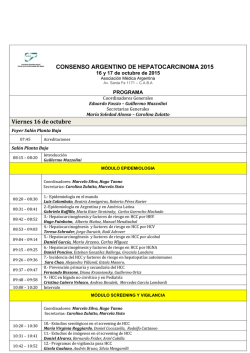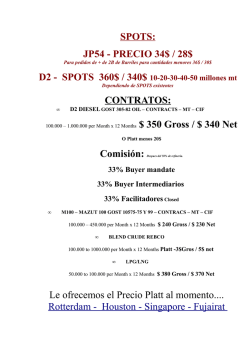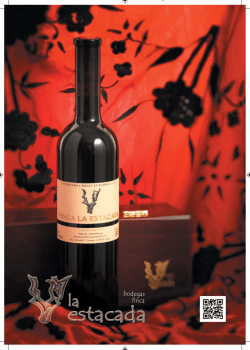
Y90. Downstaging y tratamiento en lista del hepatocarcinoma
90 Y Radioembolización Downstaging y tratamiemto en lista del HCC Fernando Pardo Clínica Universidad de Navarra Embolizing Particles for Intraarterial Therapy 300 100 35 Resin Glass Mean Diameter 35 µm 25 µm Activity/sphere 50 Bq 2,500 Bq Sangro B, et al. J Nucl Med Radiat Ther 2011 Sangro B et al. J Hepatol 2012 Tratamiento transarterial del HCC RE RE RE TACE RE Sangro B et al. J Hepatol 2012 Tto transarterial del HCC Características TACE • • • • • Isquemia ± fármaco Partículas medias-grandes Selectiva o superselectiva Varias sesiones Grandes diferencias entre Centros en dispositivos y procedimientos RE • • • • • Irradiación Partículas muy pequeñas Global a superselectiva Sesión única Procedimientos altamente reproducibles Tratamiento intra-arterial del HCC Niveles de evidencia TACE RE • Ensayos randomizados controlados (2 positivos) • Metaanalysis (3 positivos) • Grandes series prospectivas de cohortes • Nivel 1 • Nivel 2 Factores de mal pronóstico RE TACE Paciente • • • • Child-Pugh B o C Ascitis Bilirrubina > 3 mg Performance status > 1 • • • • Child-Pugh B o C Ascitis Bilirrubina > 2 mg Performance status > 1 Tumor • • • • • • Tumor ≥ 5 cm > 3 lesiones Multi-nodular/difuso Bilobar AFP ≥ 400 ng/mL Trombosis portal • • • • • > 5 lesiones Multi-nodular/difuso Bilobar AFP≥ 400 ng/mL Trombosis portal Técnica • Procedimiento poco selectivo (lobar o bilobar) Raoul J-L, et al. Cancer Treat Rev. 2011;37:212 • Procedimiento poco selectivo (lobar o bilobar) Goin J, et al. JVIR 2005;16:195 Salem R, et al. Gastro. 2010;138:52 Geschwind JF, et al. Gastro 2004;127:S194 Sangro B, et al. Hepatology. 2011;54:868 Candidatos a tratamiento intra-arterial • Estadio precoz a intermedio – – – – Lista de espera para trasplante Irresecable por localización (downstaging) Tumor único no accesible a RFA Tumores pequeños tratables superselectivamente • Estadio intermedio o avanzado – Tumor grande o múltiple no tratable superselectivamente – Invasión portal sin enfermedad extrahepática Radioembolización en HCC Suma de diámetros máximos (RECIST) 30 pacientes evaluables 30 de control: 78% Tasa de respuesta: 21 % 25 100 20 80 15 10 60 5 40 Patients with new lesions Change from basal (%) 120 Tasa 0 Basal M1 M3 M6 M9 M 12 Sangro B, et al. IJROBP 2006 TACE & RE en HCC precoz a intermedio Tratamiento en lista • Baja evidencia, amplia implantación • Recomendado con tiempo de espera estimado > 6 meses • Objetivo: evitar la progresión > criterios de Milan (u otros) Tiempo a progresión tras TACE y RE pacientes en estadio intermedio Tratamiento RE 1 RE 2 cTACE 3 DEB-TACE 4 Nº de pacientes 65 17 31 153 Criterios respuesta EASL EASL Otros mRECIST Tº medio a prog. (m) 13.3 13 4.9 5.5 1. Salem R, et al. Gastroenterology. 2011; 2. Mazzaferro V, et al. Hepatology 2013. 3. Sansonno D, et al. Oncologist. 2012; 4. Lencioni R, et al. GI 2012 Análisis retrospectivo de 86 pacientes UNOS T3 (2000-2008) TACE (43) RE (43) TACE (43) RE (43) HTP 77% 74% Ds T3 → T2 31% 58%* Único 53% 47% Tº a progresión 12.8 33.3* Child–Pugh A 53% 56% Transplantados 26% 21% BCLC B 85% 79% RFA 23% 42%* Tto selectivo 56% 46% Med SPV (cens) 18.7 35.7 Toxicidad biliar 26% 7% Med SPV (no cens) 19.2 41.6* MELD Pre/Post 9/9 8/9.5 Recidiva 18% 22% * p<0.05 Lewandowski RJ, et al. Am J Transpl. 2009 “Radiation Lobectomy” 315 tratados por RE con microesferas 101 tumor único derecho 20 pacientes desarrollaron imágenes sugestivas de lobectomía por radiación (marcada reducción de volumen ipsilobar y aumento de volumen contralateral) Gaba RC et al. Ann Surg Oncol 2009 “Radiation Lobectomy” # patients # patients Male Sex 16 Cirrhosis 12 1 11 HCC / ICC 17 / 3 2 6 Child A / B 11 / 6 3 2 5 5 1 Portal vein thrombosis No. of sessions Changes in lobar volumes at mean 18-months follow-up (range 2-49 months) Right Lobe Left Lobe Median (ml) Range (ml) % of total Pre 962 644-1842 57 Post 386 185-948 31 Pre 676 328-1387 43 Post 950 560-1558 69 Change -52% 40% 4/15 patients (27%) had bilirubin > 2 mg/dl after 6-12 months Gaba RC et al. Ann Surg Oncol 2009 First Case Report: PET/CT imaging Baseline 4 weeks post first SIRT 3 months post second SIRT Gulec SA et al. WJSO 2009 First Case Report: liver volumes Liver Volume (mL) 2500 2000 1500 1000 500 Baseline 0 Left lobe volume (mL) 418.48 Right lobe volume (mL) 1084.89 Post-1st RE ~1.5 months Post-1st RE 3 months Post-2nd RE ~4.5 months Post-2nd RE 6 months 465.59 579.11 944.48 1114.81 1461.39 1267.68 811.52 537.23 Gulec SA et al. WJSO 2009 First Case Report: intra-operative observations Atrophied right lobe with down-sized tumour / scarring 2.7x hypertrophy of the left lobe Gulec SA et al. WJSO 2009 Basal (n=35) Liver Volumes Treated Lobe (ml) 1038 Untreated Lobe (ml) 734 Lóbulo tratado 3 months (n=28) Maximum (n=35) 838 794 953 955 Lóbulo contralateral Ann Surg Oncol 2013 • • • • • • • 83 pts con HCC (63%), metástasis (32%) o CC (5%). Edad media: 66 años Cirrosis: 53% Media plaquetas: 163x109/L Media bilirrubina: 0.92 mg/dL Trombosis portal: 8.4% Lóbulo tratado: 79.5% dcho/ 20.5% izqdo HPB (Oxford) 2013 • Volumen hepático * p < 0.001 • • • Independiente del lóbulo tratado Incluso incluyendo a los pacientes con progresión contralateral No cambios significativos en el volumen hepático total Fernández-Ros N et al. HPB (Oxford) 2013 71 años, varón Cirrosis VHC (tratado con Telaprevir-PEG-Riba) Diciembre 2013: HCC de 35 mm segm V-VIII: ablación por microondas Julio 2014: progresión tumoral (7 x 6 cm nódulo difuso) Lesión 7 x 4,7 x 6,5 cm. Áreas sólido quísticas en relación con tratamiento previo. Periferia de la lesión áreas nodulares con captación de contraste y lavado en fase portal. HCC tratado, con áreas activas 90Y-microspheres PET/CT distribution single dose trans-arterial 90Y microspheres administered activity 1,8GBq. Julio 2014 Enero 2015 Volumen hepático total: 1423,6 Derecho: 987,7 (69,4 %) Izquierdo: 435,9 (30,6 %) Volumen hepático total: 1603,6 Derecho: 475,2 (30 %) Izquierdo: 1128,4 (70 %) Tumor: 7 x 6,5 cm Tumor: 4,5 x 3,5 cm Julio 2014 Enero 2015 Volumen hepático total: 1423,6 Derecho: 987,7 (69,4 %) Izquierdo: 435,9 (30,6 %) Volumen hepático total: 1603,6 Derecho: 475,2 (30 %) Izquierdo: 1128,4 (70 %) Tumor: 7 x 6,5 cm Tumor: 4,5 x 3,5 cm 70% 30,6% July 2014 January 2015 Total liver volume: 1423,6 Right: 987,7 (69,4 %) Left: 435,9 (30,6 %) Total liver volume: 1603,6 Right: 475,2 (30 %) Left: 1128,4 (70 %) Tumor: 7 x 6,5 cm Tumor: 4,5 x 3,5 cm 70% 30,6% Julio 2014 Volumen hepático total: 1423,6 Derecho: 987,7 (69,4 %) Izquierdo: 435,9 (30,6 %) Enero 2015 Volumen hepático total: 1603,6 Derecho: 475,2 (30 %) Izquierdo: 1128,4 (70 %) ICG clearance test: PDR: 11,2% R 15: 18,6% (allow for a 30% resection) Local therapies TACE DCBeads Disease control SIRT PVE Hypertrophy FLR Hepatectomía derecha laparoscópica Tiempo: 328 min Clampaje portal: 26 min Transfusion (intra/post): no/no Estancia: 3 days No morbilidad precoz ni tardía Seguimiento: 9 meses tras resección /34 meses del diagnóstico Vivo sin enfermedad Pacientes con HCC UNOS T3 tratados RE Sep 2003-Ago 2010 Grupo A Grupo B Tto RADICAL (6 pacientes: 28%) No tto radical (15 pacientes: 72%) Eur J Surg Oncol 2012 Down-Staging HCC con Y90-Radioembolización Grupo A 6 pacientes Grupo B 15 pacientes p 62 73 0.006 Sexo (hombres) 100% 73% 0.2 Cirrosis 67% 73% 1 1.0 0.9 0.3 Tratamientos previos 50% 27% 0.1 Volumen Tumoral (mL) 583 137 0.01 Sesión única 83 % 73 % 0.7 Enfermedad unilobar 100% 73% 0.2 0.37 0.89 0.34 Edad (años) Bilirrubina (mg/dL) Actividad/vol tumor (GBq/mL) Iñarrairaegui M, et al. Eur J Surg Oncol 2012 Down-Staging HCC con Y90-Radioembolización Grupo A: 6 pacientes (28.5%) Pt Edad Cirrosis Bil (mg/dl) # nódulos Tamaño (cms) AFP (UI/ml) 1 72 Sí 0.94 1 8.4 11 2 63 Sí 1.20 1 14.2 17 3 56 Sí 1.28 2 5.5 2 4 66 No 0.88 1 11.5 2 5 62 Sí 1.03 1 13.0 2 6 60 No 0.94 1 11.0 51463 Iñarrairaegui M, et al. Eur J Surg Oncol 2012 Down-Staging HCC by Y90-Radioembolization Dose Treated Radical area therapy (GBq) RFA+ Interval (months) Status Time from radical therapy 22 Alive FOD 20 mo 1 2.80 VII-VIII 2 3.25 RHL LDLT 10 Alive FOD 49 mo 3 2.05 RHL DDLT 35 Alive FOD 52 mo 4 3.02 RHL Resection 2 Alive FOD 49 mo 5 3.00; 2.00 RHL Resection 14 Alive FOD 24 mo 6 1.42 RHL Resection 11 DWD 34 mo Resection Iñarrairaegui M, et al. Eur J Surg Oncol 2012 Downstaging HCC by Y90-RE BASAL +32 mo Iñarrairaegui M, et al. Eur J Surg Oncol 2012 Downstaging HCC by Y90-RE BASAL +10 mo Iñarrairaegui M, et al. Eur J Surg Oncol 2012 Down-Staging HCC by Y90-Radioembolization Group B 15 patients Time to progression: 18 months (95%CI 0.0-42.3) FUP < 6 mo: 2 patients Progression or New Lesions 8 patients Same Stage 2 patients Changed Stage 3 patients 82 y-o Inactive Lesions Alive FOD at 40 mo Decompensated Cirrhosis Dead FOD at 6 mo Comorbility Dead at 24 mo Iñarrairaegui M, et al. Eur J Surg Oncol 2012 Down-Staging HCC by Y90-Radioembolization Survival N= 6 3-year survival: 75% Median follow-up: 48 months p= 0.005 N= 15 3-year survival: 21% Median survival: 22 months Months after Y90-RE Iñarrairaegui M, et al. Eur J Surg Oncol 2012 J Gastrointest Surg 2006 Transpl Proc 2008 Nat Rev Gastroenterol Hepatol 2009 Journal of Hepatology 2014 Kulik L et al. Journal of Hepatology 2014 RE como puente al trasplante Dosis Área (GBq) tratada Intervalo (meses) Estado Time from LTx 1 0.3 RHL 7 VSE 97 m 2 0.4 LHL 7 VSE 78 m 3 0.5 VI-VII 11 MSE (ACVA) 62 m 4 0.6 RHL 3 VSE 61 m 5 0.4 RHL 3 VCE (recidiva) 41 m 6 0.4 VIII 9 VSE 32 m 7 0.3 RHL 3 VSE 23 m 8 0.3 RHL 4 MSE (ACVA) 21 m 9 0.3 II-III 6 VSE 21 m 10 0.5 VI-VII 13 MCE (recidiva) 20 m 11 0.4 VI 7 VSE (Ca urotelio) 19 m CUN. Datos propios Seguridad de la cirugía post-SIRT - Seguro para el cirujano? - Seguro para el paciente? ? Gulec SA et al. WJSO 2009; 7: 6 SIR-Spheres ® biocompatible microspheres Rango máximo de emisión en tejido: 11 mm (media 2.5 mm) • Vida media 64.1 horas. • 94% de la radiación emitida en 11 días … dejando solo radiación de fondo. Selwyn RG. J Appl Clin Med Physics 2013 J Surg Res 2011 HPB 2011 M. Iñarrairaegui a,b,*, F. Pardo c, J.I. Bilbao d, F. Rotellar c, A. Benito d, D. D’Avola e, P. Martı c, G. Zozaya c, I. Dominguez e, J. Quiroga a,b, B. Sangro a,b a,b, J.I. Herrero a,b, M. Rodriguez EJSO 2012 Future Oncol. 2014 The Post-SIR-Spheres Surgery Study (P4S): Analysis of Outcomes following Hepatic Resection or Transplantation in 100 Patients Previously Treated with Selective Internal Radiation Therapy (SIRT) Fernando Pardo, Michael Schön, Rheun-Chuan Lee, Derek Manas, Rohan Jeyarajah, Georgios Katsanos, Geert Maleux, Bruno Sangro. P4S Study Post SIR-Spheres Surgery Estudio retrospectivo multicéntrico internacional para valorar los resultados del trasplante y la resección después de tratamiento con microesferas Y90 en pacientes con – Tumores primarios hepáticos – Metástasis hepáticas •Objetivos primarios: – Morbilidad peri y postoperatoria a 90 días – Mortalidad postoperatoria a 90 días •Objetivos secundarios: – Estancia postoperatoria – Supervivencia global – Tiempo entre SIRT y cirugía P4S Study Entered Patients Clean patients 30 11 5 7 7 5 65 2 5 7 14 30 10 5 7 7 5 64 2 5 7 14 City Country PI Clinica Universidad de Navarra Klinikum Karlsruhe UZ Gasthuisberg Institut Jules Bordet Newcastel Hospital S Orsola Malpighi EUROPE St. Francis Hospital Carolinas MC Methodist Dallas MC USA Pamplona Karlsruhe Leuven Brussels Newcastle Bologna Spain Germany Belgium Belgium UK Italy Fernando Pardo Michael Schöen Geert Maleux Vincent Donckier Derek Manas Daniele Pinna Tulsa Charlotte Dallas USA USA USA Kevin Fisher Samuel Baker Rohan Jeyarajah Chinese Univ Hong Kong Singapore General Hospital Hong Kong Singapore China Singapore Joseph Lau Pierce Chow 9 4 4 Taipei Veterans General Hospital Wakefield Gastro Clinic Austin Hospital St Vincent Hospital ASIA-OCEANIA Taipei Wakefield Austin Sydney Taiwan New Zealand Australia Australia Lee Rheun-Chuan Richard Stubbs Paul Gow Francis Chu 8 4 2 5 32 8 4 2 5 23 111 101 Center P4S Study Pacientes elegibles (n = 111) Excluidos • Datos insuficientes • Seguim. < 90 días • Tx pos-reseción† (n = 11) (n = 9) (n = 1) (n = 1) Tumores irresecables (n = 100) ± tto previo † incluido sólo en el grupo resección SIRT con SIR-Spheres 90Y resin microspheres ± otros ttos Resección (n = 71) Cirugía entre 08/98 y 05/14 Resección menor Resección mayor [1–2 segmentos] [≥3 segmentos resecados] (n = 20) (n = 51) Resección mayor [3–4 segmentos] (n =32) Resección ampliada [≥5 segmentos] (n = 19) Trasplante (n = 29) Pacientes Características Resección (N = 71) 23 (32.4%) 30 (42.3%) 7 (9.9%) 4 (5.6%) 7 (9.9%) Trasplante (N = 29) 26 (89.7%) 0 0 3 (10.3%) 0 Bilobar: 31 (43.7%) 13 (44.8%) Primario in situ (en no-HCC): 21 (44.7%) 3 (10.3%) Cirrosis: 16 (22.5%) 25 (86.2%) Tumor: HCC CCR Colangiocarcinoma Neuroendocrino Otros P4S Study SIRT Pre-cirugía Características Trasplante (N = 29) Intención de tto: Puente al trasplante Down-sizing Paliativo Nº de SIRT : 1 2 3 23 (79.3%) 5 (17.2%) 1 (3.4%) SIRT “whole liver”: 24 (82.8%) 5 (17.2%) 0 10 (34.5%) Actividad media SIRT (IQR) [rango], GBq : 1.3 (1.4) [0.3 – 3.5] ASA score: Media (IQR) ASA score ≥3 3.0 (1.0) 22 (78.6%) Bilirrubina total ≥1: 17 (60.7%) Comorbilidades pre-cirugía: 22 (75.9%) (Cardiopatía, EPOC, Diabetes, Hipertension, Insuficiencia renal, Otras) Tª medio desde SIRT (IQR), : 8.3 m (7.6) >6 meses, N (%): 19 (65.5%) Complicaciones peri-postoperatorias y resultados Complicaciones Trasplante Evolución (N = 29) CD ≥1 CD ≥3 15 (51.7%) 4 (13.8%) CD ≥1 CD ≥3 Herida: Cardiovascular Total: Estancia media días (IQR): 11.0 (10.0) 1 (3.4%) 0 Reingreso a 90 días: 9 (31.0%) CD ≥1 CD ≥3 1 (3.4%) 0 Mortalidad CD ≥1 CD ≥3 1 (3.4%) 0 Pulmonar CD ≥1 CD ≥3 1 (3.4%) 0 Renal CD ≥1 CD ≥3 2 (6.9%) 0 Fallo hepático: 30 días 90 días 0 0 SIRT Cirugía 48.3 meses 40.2 meses Seguimiento medio: Conclusiones Estudio P4S • El perfil de seguridad del Tx post-SIRT es similar a lo publicado en trasplante • No hay muertes relacionadas con SIRT Integration of SIRT in the HCC BCLC staging classification and treatment schedule HCC PS 0 Child A PS 0–2 Child A–B PS >2 Child C Stage 0 Very Early Stage Stage A Early Stage Stage B Intermediate Stage Stage C Advanced Stage Stage D End Stage single <2 cm or carcinoma in situ single nodule or 3 nodules <3 cm PS 0 portal vein invasion, N1 M1 or PS 1–2 PS >2 or Child C multinodular; PS 0 portal pressure; bilirubin normal single 3 nodules <3 cm increased associated diseases no unilobar fewer nodules smaller burden bilobar multinodular larger burden failed TACE yes SIRT? Resection Liver Transplant Ablation Curative Treatments – 5-yr survival 40–70% 30% of patients TACE SIRT OS 20 months (14-45) 20% of patients (unless within transplant criteria) fit/suitable fit/suitable for SIRT i.e. for sorafenib liver-dominant; i.e. bilirubin main PVT <2 mg/dL; EHD Child A or <B7 SIRT/ sorafenib sorafenib OS 11 months (6-14) 40% of patients symptomatic OS <3 mo 10% of patients ¡Muchas gracias!
© Copyright 2024


